Entrepreneurship and Small Business Management: February 2019 Report
VerifiedAdded on 2020/12/29
|20
|6140
|446
Report
AI Summary
This report, focused on entrepreneurship and small business management, explores various aspects of ventures and their impact on the UK economy. It begins by defining entrepreneurship and outlining different venture types, including high-growth, small business, and lifestyle ventures, along with their typologies. The report then differentiates between these venture types, highlighting similarities and differences. Furthermore, it analyzes the significant impact of small businesses on the UK economy, emphasizing their role in job creation, GDP contribution, and economic development. The report also delves into the key traits and skills of successful entrepreneurs, using the OCEAN model to determine aspects of personality that reflect the entrepreneurial motivation and mindset. Finally, the report touches upon how the background and experience of an entrepreneur can either hinder or foster entrepreneurship. The report concludes by summarizing the key findings and their implications for starting and managing successful businesses.

Managing a Successful Business Project
Tutor: Dr Reza Aboutalebi
Session: February 2019
Tutor: Dr Reza Aboutalebi
Session: February 2019
Paraphrase This Document
Need a fresh take? Get an instant paraphrase of this document with our AI Paraphraser

Entrepreneurship and
Small Business
Management
Small Business
Management
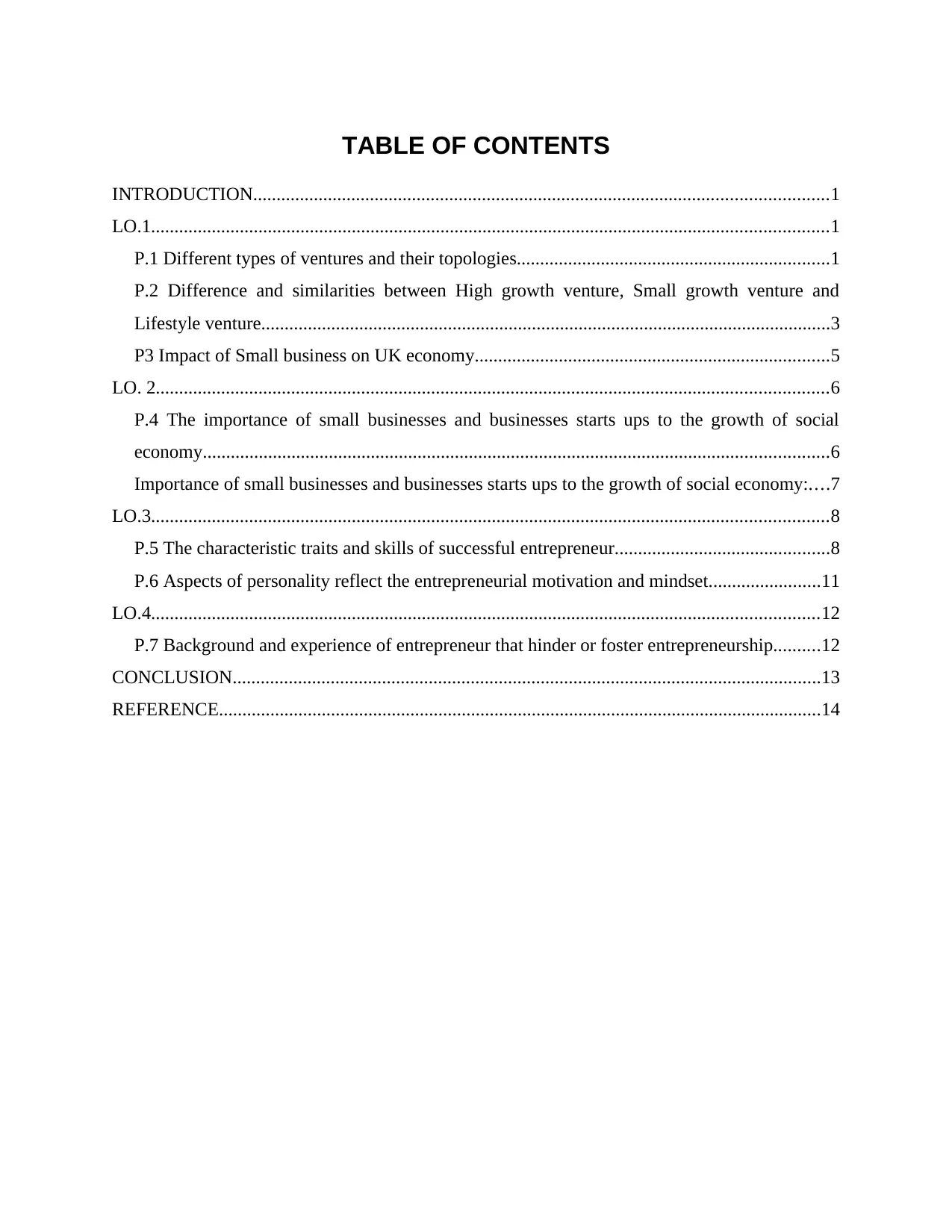
TABLE OF CONTENTS
INTRODUCTION...........................................................................................................................1
LO.1.................................................................................................................................................1
P.1 Different types of ventures and their topologies...................................................................1
P.2 Difference and similarities between High growth venture, Small growth venture and
Lifestyle venture..........................................................................................................................3
P3 Impact of Small business on UK economy............................................................................5
LO. 2................................................................................................................................................6
P.4 The importance of small businesses and businesses starts ups to the growth of social
economy......................................................................................................................................6
Importance of small businesses and businesses starts ups to the growth of social economy:....7
LO.3.................................................................................................................................................8
P.5 The characteristic traits and skills of successful entrepreneur..............................................8
P.6 Aspects of personality reflect the entrepreneurial motivation and mindset........................11
LO.4...............................................................................................................................................12
P.7 Background and experience of entrepreneur that hinder or foster entrepreneurship..........12
CONCLUSION..............................................................................................................................13
REFERENCE.................................................................................................................................14
INTRODUCTION...........................................................................................................................1
LO.1.................................................................................................................................................1
P.1 Different types of ventures and their topologies...................................................................1
P.2 Difference and similarities between High growth venture, Small growth venture and
Lifestyle venture..........................................................................................................................3
P3 Impact of Small business on UK economy............................................................................5
LO. 2................................................................................................................................................6
P.4 The importance of small businesses and businesses starts ups to the growth of social
economy......................................................................................................................................6
Importance of small businesses and businesses starts ups to the growth of social economy:....7
LO.3.................................................................................................................................................8
P.5 The characteristic traits and skills of successful entrepreneur..............................................8
P.6 Aspects of personality reflect the entrepreneurial motivation and mindset........................11
LO.4...............................................................................................................................................12
P.7 Background and experience of entrepreneur that hinder or foster entrepreneurship..........12
CONCLUSION..............................................................................................................................13
REFERENCE.................................................................................................................................14
⊘ This is a preview!⊘
Do you want full access?
Subscribe today to unlock all pages.

Trusted by 1+ million students worldwide
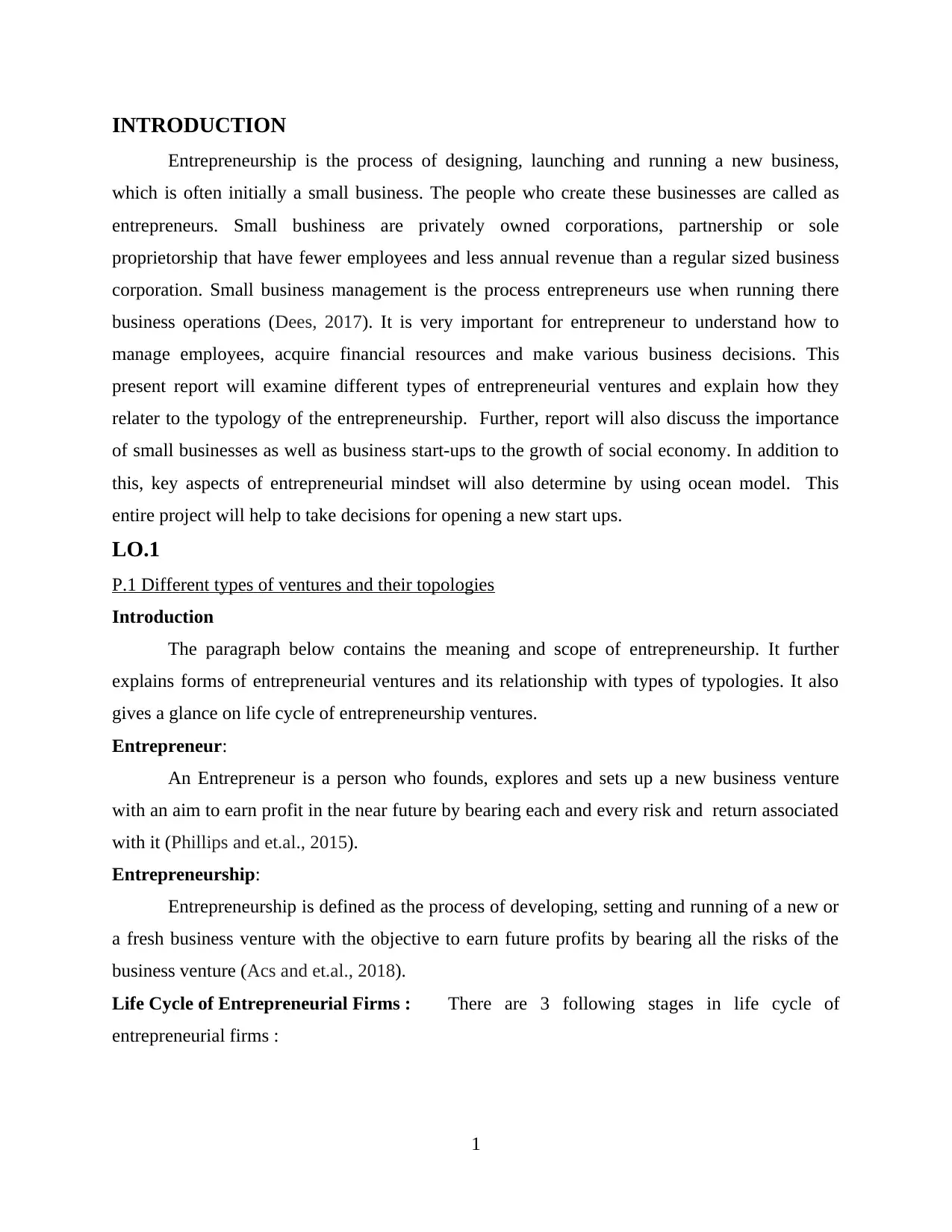
INTRODUCTION
Entrepreneurship is the process of designing, launching and running a new business,
which is often initially a small business. The people who create these businesses are called as
entrepreneurs. Small bushiness are privately owned corporations, partnership or sole
proprietorship that have fewer employees and less annual revenue than a regular sized business
corporation. Small business management is the process entrepreneurs use when running there
business operations (Dees, 2017). It is very important for entrepreneur to understand how to
manage employees, acquire financial resources and make various business decisions. This
present report will examine different types of entrepreneurial ventures and explain how they
relater to the typology of the entrepreneurship. Further, report will also discuss the importance
of small businesses as well as business start-ups to the growth of social economy. In addition to
this, key aspects of entrepreneurial mindset will also determine by using ocean model. This
entire project will help to take decisions for opening a new start ups.
LO.1
P.1 Different types of ventures and their topologies
Introduction
The paragraph below contains the meaning and scope of entrepreneurship. It further
explains forms of entrepreneurial ventures and its relationship with types of typologies. It also
gives a glance on life cycle of entrepreneurship ventures.
Entrepreneur:
An Entrepreneur is a person who founds, explores and sets up a new business venture
with an aim to earn profit in the near future by bearing each and every risk and return associated
with it (Phillips and et.al., 2015).
Entrepreneurship:
Entrepreneurship is defined as the process of developing, setting and running of a new or
a fresh business venture with the objective to earn future profits by bearing all the risks of the
business venture (Acs and et.al., 2018).
Life Cycle of Entrepreneurial Firms : There are 3 following stages in life cycle of
entrepreneurial firms :
1
Entrepreneurship is the process of designing, launching and running a new business,
which is often initially a small business. The people who create these businesses are called as
entrepreneurs. Small bushiness are privately owned corporations, partnership or sole
proprietorship that have fewer employees and less annual revenue than a regular sized business
corporation. Small business management is the process entrepreneurs use when running there
business operations (Dees, 2017). It is very important for entrepreneur to understand how to
manage employees, acquire financial resources and make various business decisions. This
present report will examine different types of entrepreneurial ventures and explain how they
relater to the typology of the entrepreneurship. Further, report will also discuss the importance
of small businesses as well as business start-ups to the growth of social economy. In addition to
this, key aspects of entrepreneurial mindset will also determine by using ocean model. This
entire project will help to take decisions for opening a new start ups.
LO.1
P.1 Different types of ventures and their topologies
Introduction
The paragraph below contains the meaning and scope of entrepreneurship. It further
explains forms of entrepreneurial ventures and its relationship with types of typologies. It also
gives a glance on life cycle of entrepreneurship ventures.
Entrepreneur:
An Entrepreneur is a person who founds, explores and sets up a new business venture
with an aim to earn profit in the near future by bearing each and every risk and return associated
with it (Phillips and et.al., 2015).
Entrepreneurship:
Entrepreneurship is defined as the process of developing, setting and running of a new or
a fresh business venture with the objective to earn future profits by bearing all the risks of the
business venture (Acs and et.al., 2018).
Life Cycle of Entrepreneurial Firms : There are 3 following stages in life cycle of
entrepreneurial firms :
1
Paraphrase This Document
Need a fresh take? Get an instant paraphrase of this document with our AI Paraphraser
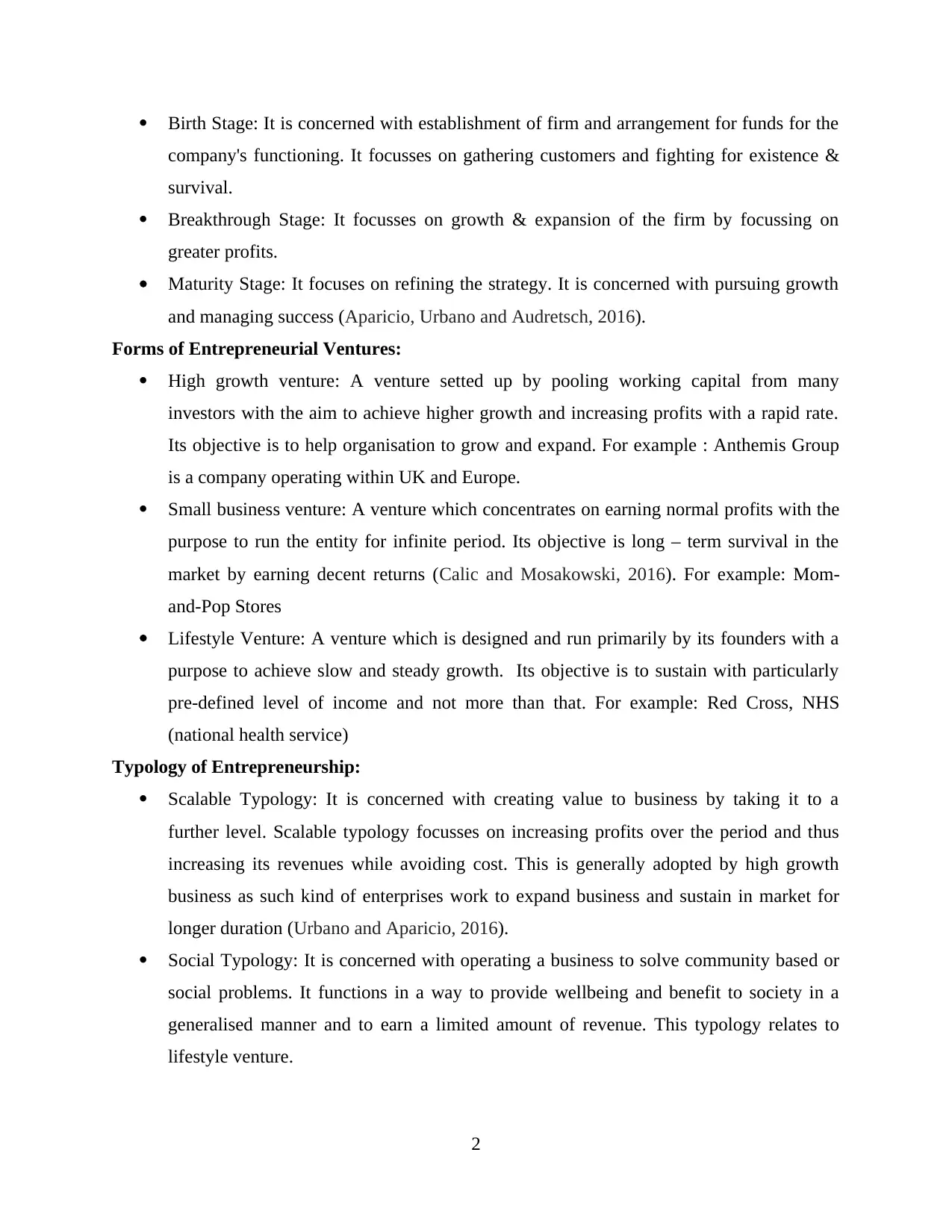
Birth Stage: It is concerned with establishment of firm and arrangement for funds for the
company's functioning. It focusses on gathering customers and fighting for existence &
survival.
Breakthrough Stage: It focusses on growth & expansion of the firm by focussing on
greater profits.
Maturity Stage: It focuses on refining the strategy. It is concerned with pursuing growth
and managing success (Aparicio, Urbano and Audretsch, 2016).
Forms of Entrepreneurial Ventures:
High growth venture: A venture setted up by pooling working capital from many
investors with the aim to achieve higher growth and increasing profits with a rapid rate.
Its objective is to help organisation to grow and expand. For example : Anthemis Group
is a company operating within UK and Europe.
Small business venture: A venture which concentrates on earning normal profits with the
purpose to run the entity for infinite period. Its objective is long – term survival in the
market by earning decent returns (Calic and Mosakowski, 2016). For example: Mom-
and-Pop Stores
Lifestyle Venture: A venture which is designed and run primarily by its founders with a
purpose to achieve slow and steady growth. Its objective is to sustain with particularly
pre-defined level of income and not more than that. For example: Red Cross, NHS
(national health service)
Typology of Entrepreneurship:
Scalable Typology: It is concerned with creating value to business by taking it to a
further level. Scalable typology focusses on increasing profits over the period and thus
increasing its revenues while avoiding cost. This is generally adopted by high growth
business as such kind of enterprises work to expand business and sustain in market for
longer duration (Urbano and Aparicio, 2016).
Social Typology: It is concerned with operating a business to solve community based or
social problems. It functions in a way to provide wellbeing and benefit to society in a
generalised manner and to earn a limited amount of revenue. This typology relates to
lifestyle venture.
2
company's functioning. It focusses on gathering customers and fighting for existence &
survival.
Breakthrough Stage: It focusses on growth & expansion of the firm by focussing on
greater profits.
Maturity Stage: It focuses on refining the strategy. It is concerned with pursuing growth
and managing success (Aparicio, Urbano and Audretsch, 2016).
Forms of Entrepreneurial Ventures:
High growth venture: A venture setted up by pooling working capital from many
investors with the aim to achieve higher growth and increasing profits with a rapid rate.
Its objective is to help organisation to grow and expand. For example : Anthemis Group
is a company operating within UK and Europe.
Small business venture: A venture which concentrates on earning normal profits with the
purpose to run the entity for infinite period. Its objective is long – term survival in the
market by earning decent returns (Calic and Mosakowski, 2016). For example: Mom-
and-Pop Stores
Lifestyle Venture: A venture which is designed and run primarily by its founders with a
purpose to achieve slow and steady growth. Its objective is to sustain with particularly
pre-defined level of income and not more than that. For example: Red Cross, NHS
(national health service)
Typology of Entrepreneurship:
Scalable Typology: It is concerned with creating value to business by taking it to a
further level. Scalable typology focusses on increasing profits over the period and thus
increasing its revenues while avoiding cost. This is generally adopted by high growth
business as such kind of enterprises work to expand business and sustain in market for
longer duration (Urbano and Aparicio, 2016).
Social Typology: It is concerned with operating a business to solve community based or
social problems. It functions in a way to provide wellbeing and benefit to society in a
generalised manner and to earn a limited amount of revenue. This typology relates to
lifestyle venture.
2
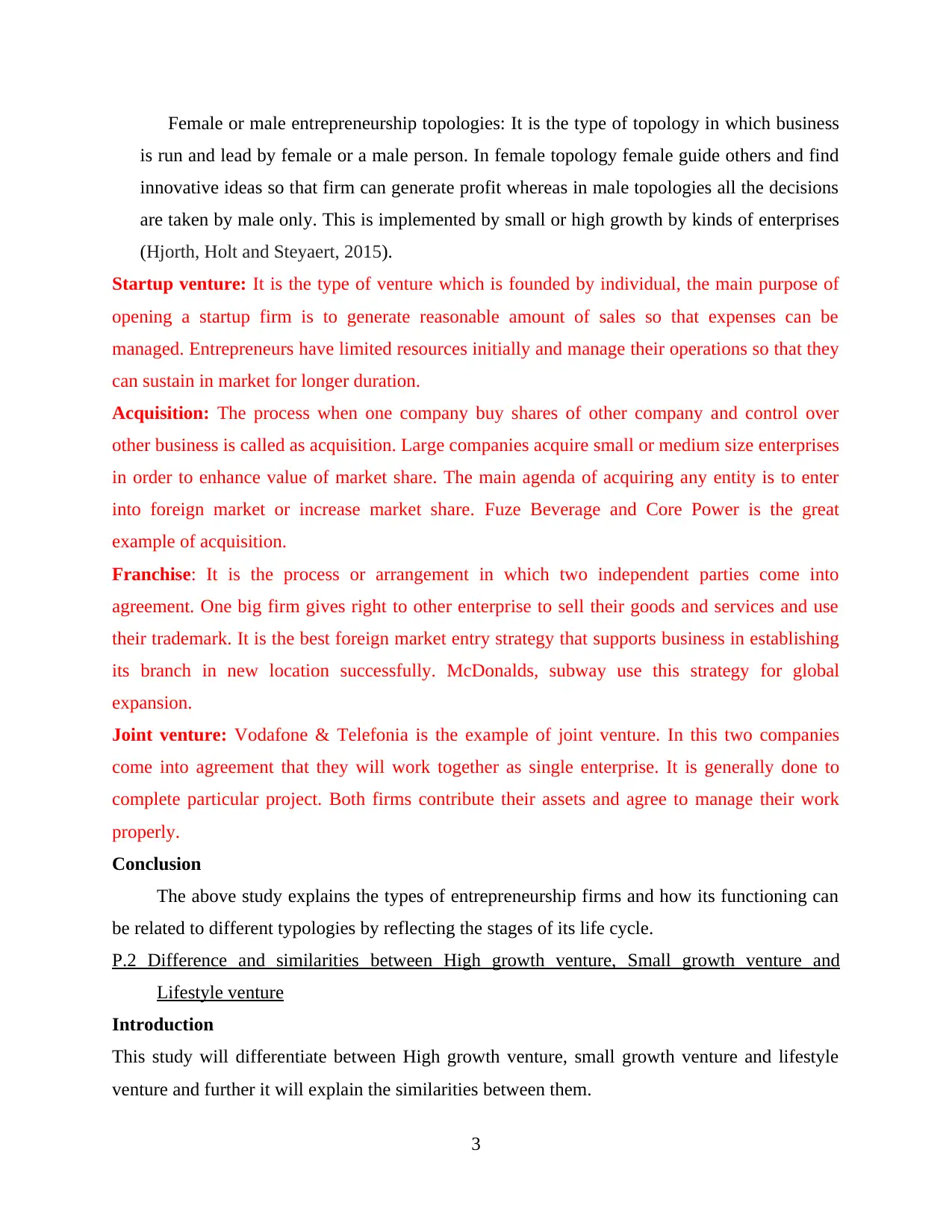
Female or male entrepreneurship topologies: It is the type of topology in which business
is run and lead by female or a male person. In female topology female guide others and find
innovative ideas so that firm can generate profit whereas in male topologies all the decisions
are taken by male only. This is implemented by small or high growth by kinds of enterprises
(Hjorth, Holt and Steyaert, 2015).
Startup venture: It is the type of venture which is founded by individual, the main purpose of
opening a startup firm is to generate reasonable amount of sales so that expenses can be
managed. Entrepreneurs have limited resources initially and manage their operations so that they
can sustain in market for longer duration.
Acquisition: The process when one company buy shares of other company and control over
other business is called as acquisition. Large companies acquire small or medium size enterprises
in order to enhance value of market share. The main agenda of acquiring any entity is to enter
into foreign market or increase market share. Fuze Beverage and Core Power is the great
example of acquisition.
Franchise: It is the process or arrangement in which two independent parties come into
agreement. One big firm gives right to other enterprise to sell their goods and services and use
their trademark. It is the best foreign market entry strategy that supports business in establishing
its branch in new location successfully. McDonalds, subway use this strategy for global
expansion.
Joint venture: Vodafone & Telefonia is the example of joint venture. In this two companies
come into agreement that they will work together as single enterprise. It is generally done to
complete particular project. Both firms contribute their assets and agree to manage their work
properly.
Conclusion
The above study explains the types of entrepreneurship firms and how its functioning can
be related to different typologies by reflecting the stages of its life cycle.
P.2 Difference and similarities between High growth venture, Small growth venture and
Lifestyle venture
Introduction
This study will differentiate between High growth venture, small growth venture and lifestyle
venture and further it will explain the similarities between them.
3
is run and lead by female or a male person. In female topology female guide others and find
innovative ideas so that firm can generate profit whereas in male topologies all the decisions
are taken by male only. This is implemented by small or high growth by kinds of enterprises
(Hjorth, Holt and Steyaert, 2015).
Startup venture: It is the type of venture which is founded by individual, the main purpose of
opening a startup firm is to generate reasonable amount of sales so that expenses can be
managed. Entrepreneurs have limited resources initially and manage their operations so that they
can sustain in market for longer duration.
Acquisition: The process when one company buy shares of other company and control over
other business is called as acquisition. Large companies acquire small or medium size enterprises
in order to enhance value of market share. The main agenda of acquiring any entity is to enter
into foreign market or increase market share. Fuze Beverage and Core Power is the great
example of acquisition.
Franchise: It is the process or arrangement in which two independent parties come into
agreement. One big firm gives right to other enterprise to sell their goods and services and use
their trademark. It is the best foreign market entry strategy that supports business in establishing
its branch in new location successfully. McDonalds, subway use this strategy for global
expansion.
Joint venture: Vodafone & Telefonia is the example of joint venture. In this two companies
come into agreement that they will work together as single enterprise. It is generally done to
complete particular project. Both firms contribute their assets and agree to manage their work
properly.
Conclusion
The above study explains the types of entrepreneurship firms and how its functioning can
be related to different typologies by reflecting the stages of its life cycle.
P.2 Difference and similarities between High growth venture, Small growth venture and
Lifestyle venture
Introduction
This study will differentiate between High growth venture, small growth venture and lifestyle
venture and further it will explain the similarities between them.
3
⊘ This is a preview!⊘
Do you want full access?
Subscribe today to unlock all pages.

Trusted by 1+ million students worldwide
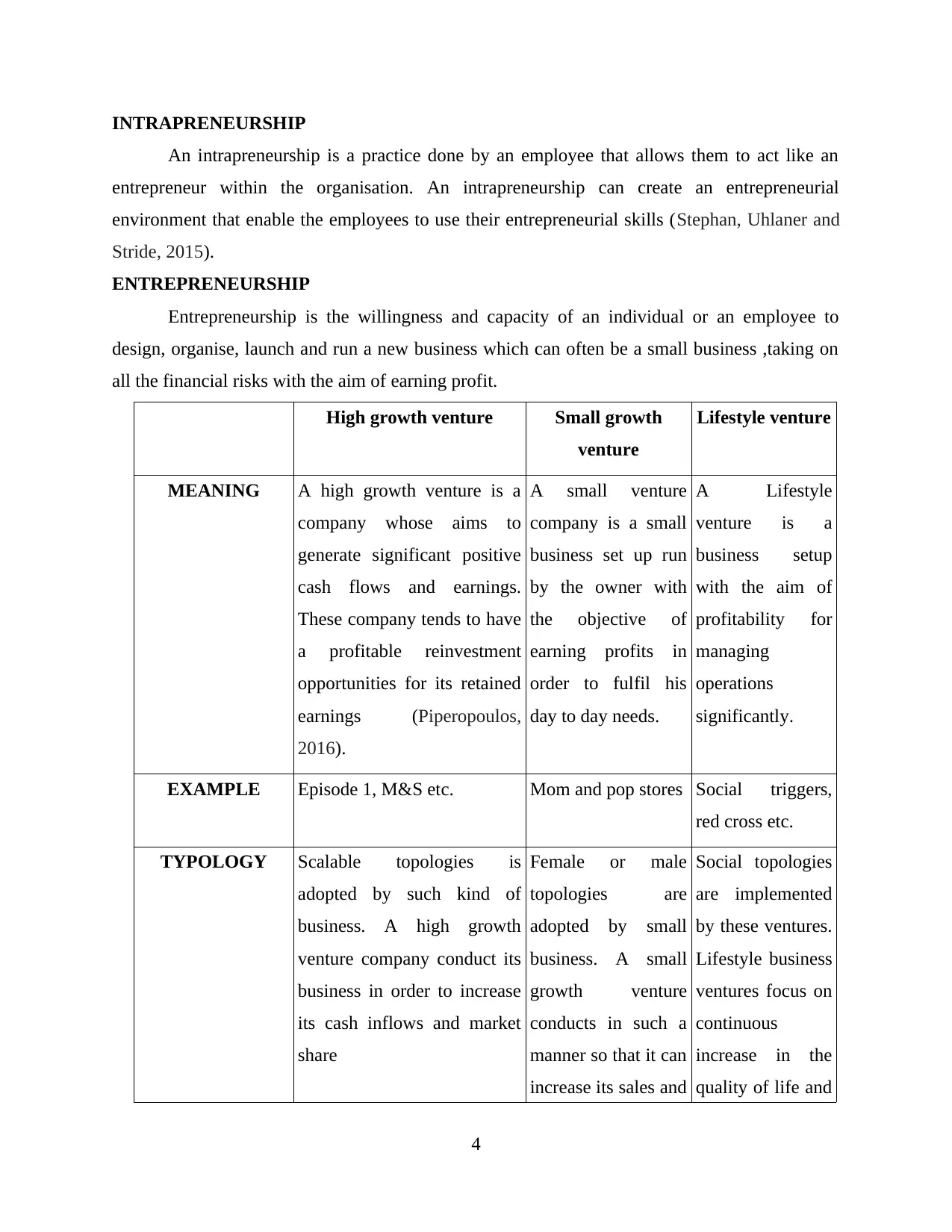
INTRAPRENEURSHIP
An intrapreneurship is a practice done by an employee that allows them to act like an
entrepreneur within the organisation. An intrapreneurship can create an entrepreneurial
environment that enable the employees to use their entrepreneurial skills (Stephan, Uhlaner and
Stride, 2015).
ENTREPRENEURSHIP
Entrepreneurship is the willingness and capacity of an individual or an employee to
design, organise, launch and run a new business which can often be a small business ,taking on
all the financial risks with the aim of earning profit.
High growth venture Small growth
venture
Lifestyle venture
MEANING A high growth venture is a
company whose aims to
generate significant positive
cash flows and earnings.
These company tends to have
a profitable reinvestment
opportunities for its retained
earnings (Piperopoulos,
2016).
A small venture
company is a small
business set up run
by the owner with
the objective of
earning profits in
order to fulfil his
day to day needs.
A Lifestyle
venture is a
business setup
with the aim of
profitability for
managing
operations
significantly.
EXAMPLE Episode 1, M&S etc. Mom and pop stores Social triggers,
red cross etc.
TYPOLOGY Scalable topologies is
adopted by such kind of
business. A high growth
venture company conduct its
business in order to increase
its cash inflows and market
share
Female or male
topologies are
adopted by small
business. A small
growth venture
conducts in such a
manner so that it can
increase its sales and
Social topologies
are implemented
by these ventures.
Lifestyle business
ventures focus on
continuous
increase in the
quality of life and
4
An intrapreneurship is a practice done by an employee that allows them to act like an
entrepreneur within the organisation. An intrapreneurship can create an entrepreneurial
environment that enable the employees to use their entrepreneurial skills (Stephan, Uhlaner and
Stride, 2015).
ENTREPRENEURSHIP
Entrepreneurship is the willingness and capacity of an individual or an employee to
design, organise, launch and run a new business which can often be a small business ,taking on
all the financial risks with the aim of earning profit.
High growth venture Small growth
venture
Lifestyle venture
MEANING A high growth venture is a
company whose aims to
generate significant positive
cash flows and earnings.
These company tends to have
a profitable reinvestment
opportunities for its retained
earnings (Piperopoulos,
2016).
A small venture
company is a small
business set up run
by the owner with
the objective of
earning profits in
order to fulfil his
day to day needs.
A Lifestyle
venture is a
business setup
with the aim of
profitability for
managing
operations
significantly.
EXAMPLE Episode 1, M&S etc. Mom and pop stores Social triggers,
red cross etc.
TYPOLOGY Scalable topologies is
adopted by such kind of
business. A high growth
venture company conduct its
business in order to increase
its cash inflows and market
share
Female or male
topologies are
adopted by small
business. A small
growth venture
conducts in such a
manner so that it can
increase its sales and
Social topologies
are implemented
by these ventures.
Lifestyle business
ventures focus on
continuous
increase in the
quality of life and
4
Paraphrase This Document
Need a fresh take? Get an instant paraphrase of this document with our AI Paraphraser
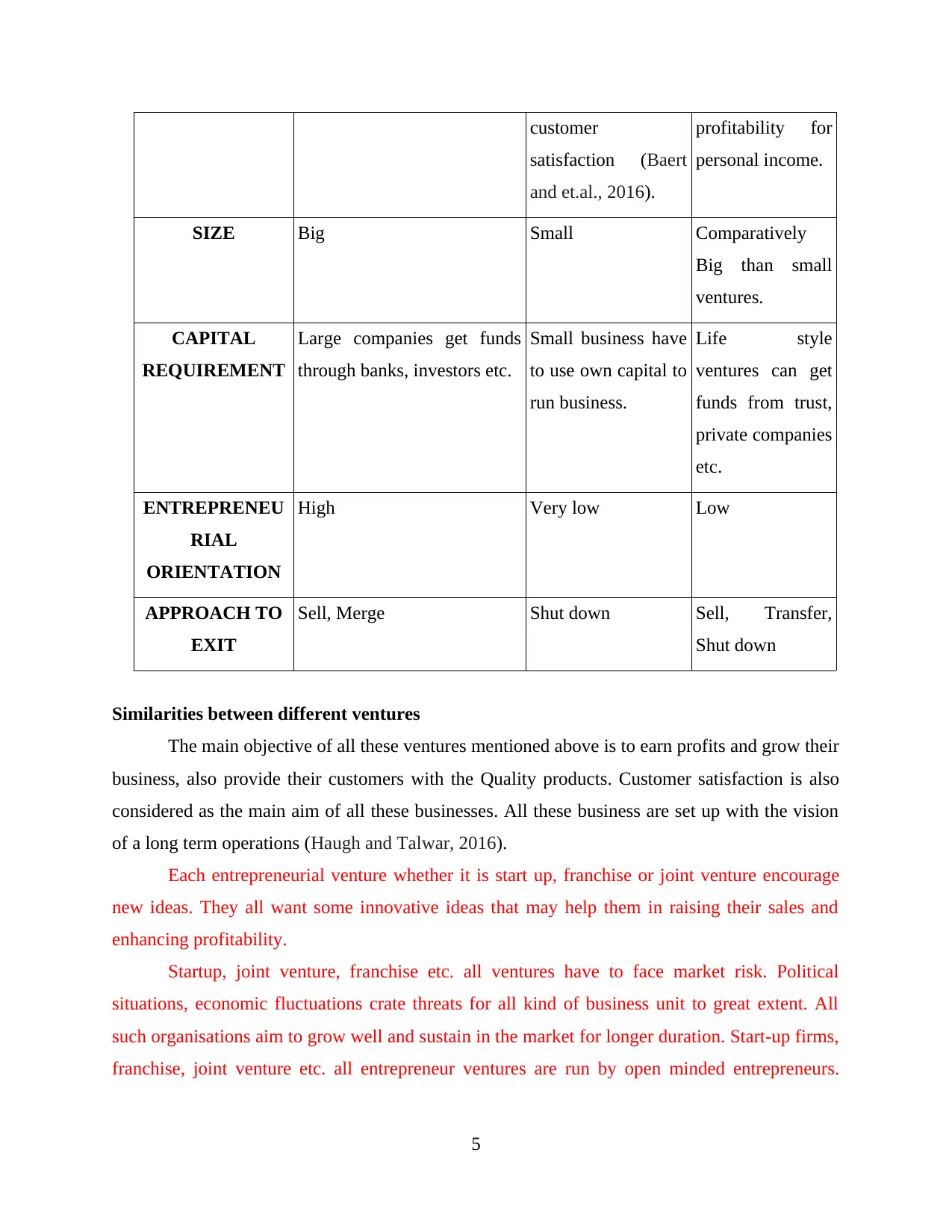
customer
satisfaction (Baert
and et.al., 2016).
profitability for
personal income.
SIZE Big Small Comparatively
Big than small
ventures.
CAPITAL
REQUIREMENT
Large companies get funds
through banks, investors etc.
Small business have
to use own capital to
run business.
Life style
ventures can get
funds from trust,
private companies
etc.
ENTREPRENEU
RIAL
ORIENTATION
High Very low Low
APPROACH TO
EXIT
Sell, Merge Shut down Sell, Transfer,
Shut down
Similarities between different ventures
The main objective of all these ventures mentioned above is to earn profits and grow their
business, also provide their customers with the Quality products. Customer satisfaction is also
considered as the main aim of all these businesses. All these business are set up with the vision
of a long term operations (Haugh and Talwar, 2016).
Each entrepreneurial venture whether it is start up, franchise or joint venture encourage
new ideas. They all want some innovative ideas that may help them in raising their sales and
enhancing profitability.
Startup, joint venture, franchise etc. all ventures have to face market risk. Political
situations, economic fluctuations crate threats for all kind of business unit to great extent. All
such organisations aim to grow well and sustain in the market for longer duration. Start-up firms,
franchise, joint venture etc. all entrepreneur ventures are run by open minded entrepreneurs.
5
satisfaction (Baert
and et.al., 2016).
profitability for
personal income.
SIZE Big Small Comparatively
Big than small
ventures.
CAPITAL
REQUIREMENT
Large companies get funds
through banks, investors etc.
Small business have
to use own capital to
run business.
Life style
ventures can get
funds from trust,
private companies
etc.
ENTREPRENEU
RIAL
ORIENTATION
High Very low Low
APPROACH TO
EXIT
Sell, Merge Shut down Sell, Transfer,
Shut down
Similarities between different ventures
The main objective of all these ventures mentioned above is to earn profits and grow their
business, also provide their customers with the Quality products. Customer satisfaction is also
considered as the main aim of all these businesses. All these business are set up with the vision
of a long term operations (Haugh and Talwar, 2016).
Each entrepreneurial venture whether it is start up, franchise or joint venture encourage
new ideas. They all want some innovative ideas that may help them in raising their sales and
enhancing profitability.
Startup, joint venture, franchise etc. all ventures have to face market risk. Political
situations, economic fluctuations crate threats for all kind of business unit to great extent. All
such organisations aim to grow well and sustain in the market for longer duration. Start-up firms,
franchise, joint venture etc. all entrepreneur ventures are run by open minded entrepreneurs.
5
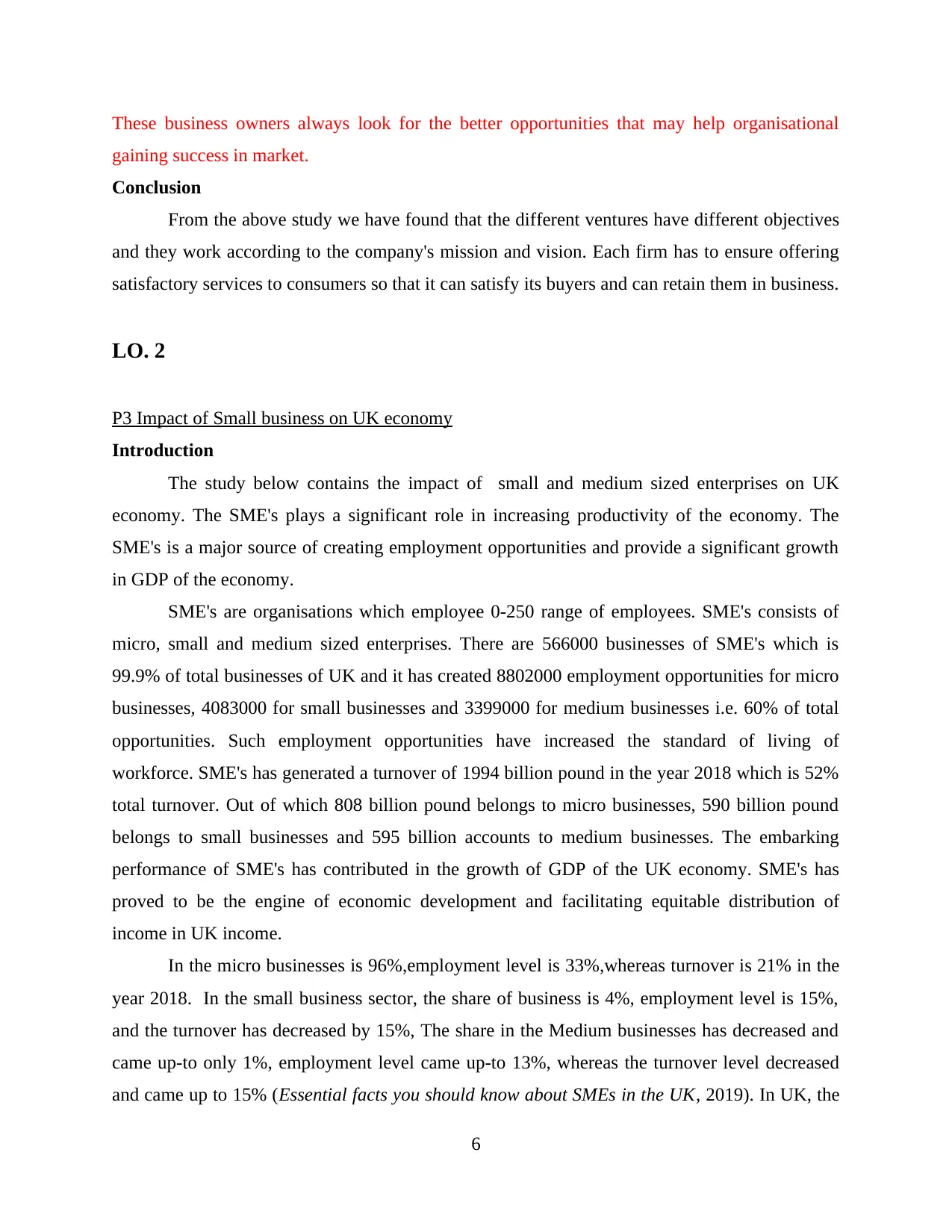
These business owners always look for the better opportunities that may help organisational
gaining success in market.
Conclusion
From the above study we have found that the different ventures have different objectives
and they work according to the company's mission and vision. Each firm has to ensure offering
satisfactory services to consumers so that it can satisfy its buyers and can retain them in business.
LO. 2
P3 Impact of Small business on UK economy
Introduction
The study below contains the impact of small and medium sized enterprises on UK
economy. The SME's plays a significant role in increasing productivity of the economy. The
SME's is a major source of creating employment opportunities and provide a significant growth
in GDP of the economy.
SME's are organisations which employee 0-250 range of employees. SME's consists of
micro, small and medium sized enterprises. There are 566000 businesses of SME's which is
99.9% of total businesses of UK and it has created 8802000 employment opportunities for micro
businesses, 4083000 for small businesses and 3399000 for medium businesses i.e. 60% of total
opportunities. Such employment opportunities have increased the standard of living of
workforce. SME's has generated a turnover of 1994 billion pound in the year 2018 which is 52%
total turnover. Out of which 808 billion pound belongs to micro businesses, 590 billion pound
belongs to small businesses and 595 billion accounts to medium businesses. The embarking
performance of SME's has contributed in the growth of GDP of the UK economy. SME's has
proved to be the engine of economic development and facilitating equitable distribution of
income in UK income.
In the micro businesses is 96%,employment level is 33%,whereas turnover is 21% in the
year 2018. In the small business sector, the share of business is 4%, employment level is 15%,
and the turnover has decreased by 15%, The share in the Medium businesses has decreased and
came up-to only 1%, employment level came up-to 13%, whereas the turnover level decreased
and came up to 15% (Essential facts you should know about SMEs in the UK, 2019). In UK, the
6
gaining success in market.
Conclusion
From the above study we have found that the different ventures have different objectives
and they work according to the company's mission and vision. Each firm has to ensure offering
satisfactory services to consumers so that it can satisfy its buyers and can retain them in business.
LO. 2
P3 Impact of Small business on UK economy
Introduction
The study below contains the impact of small and medium sized enterprises on UK
economy. The SME's plays a significant role in increasing productivity of the economy. The
SME's is a major source of creating employment opportunities and provide a significant growth
in GDP of the economy.
SME's are organisations which employee 0-250 range of employees. SME's consists of
micro, small and medium sized enterprises. There are 566000 businesses of SME's which is
99.9% of total businesses of UK and it has created 8802000 employment opportunities for micro
businesses, 4083000 for small businesses and 3399000 for medium businesses i.e. 60% of total
opportunities. Such employment opportunities have increased the standard of living of
workforce. SME's has generated a turnover of 1994 billion pound in the year 2018 which is 52%
total turnover. Out of which 808 billion pound belongs to micro businesses, 590 billion pound
belongs to small businesses and 595 billion accounts to medium businesses. The embarking
performance of SME's has contributed in the growth of GDP of the UK economy. SME's has
proved to be the engine of economic development and facilitating equitable distribution of
income in UK income.
In the micro businesses is 96%,employment level is 33%,whereas turnover is 21% in the
year 2018. In the small business sector, the share of business is 4%, employment level is 15%,
and the turnover has decreased by 15%, The share in the Medium businesses has decreased and
came up-to only 1%, employment level came up-to 13%, whereas the turnover level decreased
and came up to 15% (Essential facts you should know about SMEs in the UK, 2019). In UK, the
6
⊘ This is a preview!⊘
Do you want full access?
Subscribe today to unlock all pages.

Trusted by 1+ million students worldwide
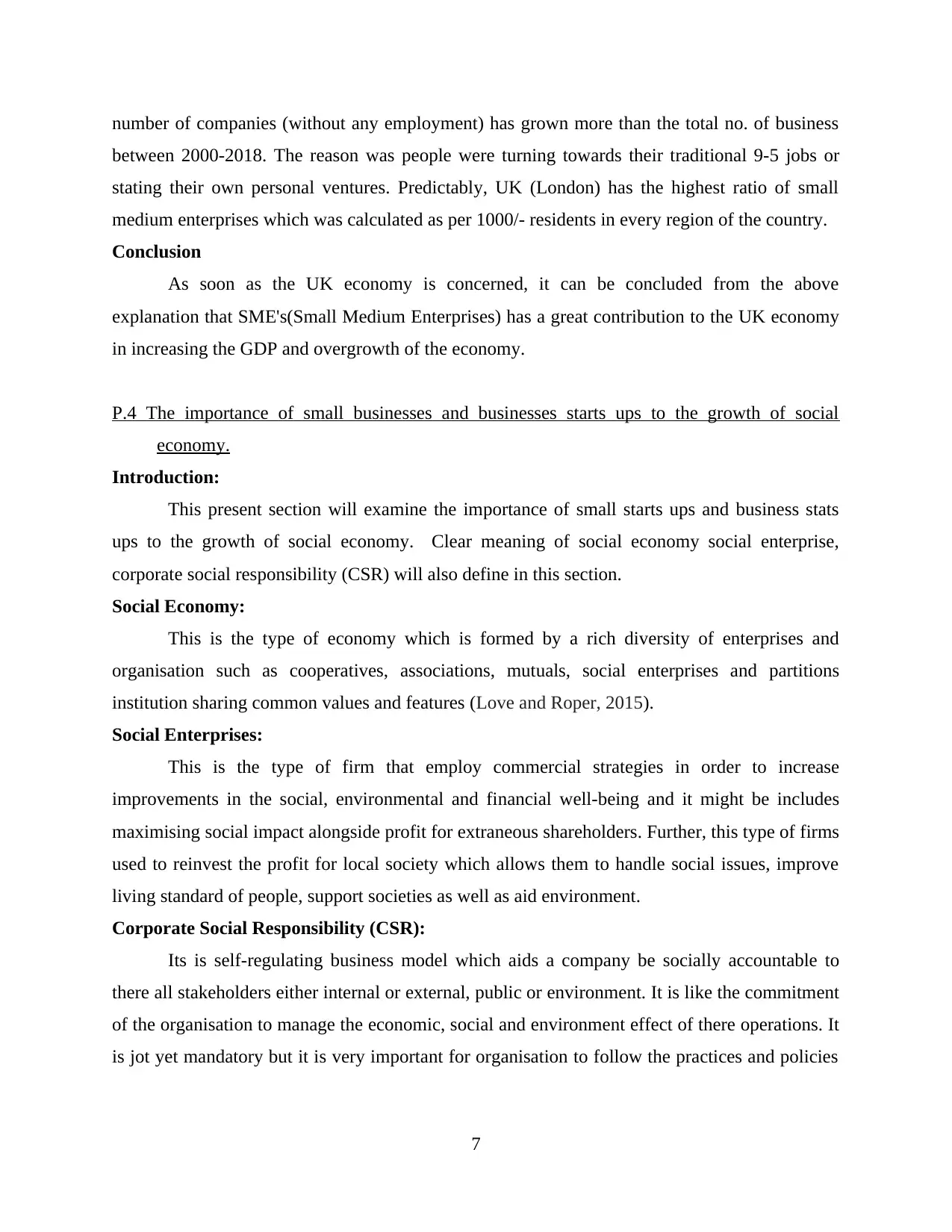
number of companies (without any employment) has grown more than the total no. of business
between 2000-2018. The reason was people were turning towards their traditional 9-5 jobs or
stating their own personal ventures. Predictably, UK (London) has the highest ratio of small
medium enterprises which was calculated as per 1000/- residents in every region of the country.
Conclusion
As soon as the UK economy is concerned, it can be concluded from the above
explanation that SME's(Small Medium Enterprises) has a great contribution to the UK economy
in increasing the GDP and overgrowth of the economy.
P.4 The importance of small businesses and businesses starts ups to the growth of social
economy.
Introduction:
This present section will examine the importance of small starts ups and business stats
ups to the growth of social economy. Clear meaning of social economy social enterprise,
corporate social responsibility (CSR) will also define in this section.
Social Economy:
This is the type of economy which is formed by a rich diversity of enterprises and
organisation such as cooperatives, associations, mutuals, social enterprises and partitions
institution sharing common values and features (Love and Roper, 2015).
Social Enterprises:
This is the type of firm that employ commercial strategies in order to increase
improvements in the social, environmental and financial well-being and it might be includes
maximising social impact alongside profit for extraneous shareholders. Further, this type of firms
used to reinvest the profit for local society which allows them to handle social issues, improve
living standard of people, support societies as well as aid environment.
Corporate Social Responsibility (CSR):
Its is self-regulating business model which aids a company be socially accountable to
there all stakeholders either internal or external, public or environment. It is like the commitment
of the organisation to manage the economic, social and environment effect of there operations. It
is jot yet mandatory but it is very important for organisation to follow the practices and policies
7
between 2000-2018. The reason was people were turning towards their traditional 9-5 jobs or
stating their own personal ventures. Predictably, UK (London) has the highest ratio of small
medium enterprises which was calculated as per 1000/- residents in every region of the country.
Conclusion
As soon as the UK economy is concerned, it can be concluded from the above
explanation that SME's(Small Medium Enterprises) has a great contribution to the UK economy
in increasing the GDP and overgrowth of the economy.
P.4 The importance of small businesses and businesses starts ups to the growth of social
economy.
Introduction:
This present section will examine the importance of small starts ups and business stats
ups to the growth of social economy. Clear meaning of social economy social enterprise,
corporate social responsibility (CSR) will also define in this section.
Social Economy:
This is the type of economy which is formed by a rich diversity of enterprises and
organisation such as cooperatives, associations, mutuals, social enterprises and partitions
institution sharing common values and features (Love and Roper, 2015).
Social Enterprises:
This is the type of firm that employ commercial strategies in order to increase
improvements in the social, environmental and financial well-being and it might be includes
maximising social impact alongside profit for extraneous shareholders. Further, this type of firms
used to reinvest the profit for local society which allows them to handle social issues, improve
living standard of people, support societies as well as aid environment.
Corporate Social Responsibility (CSR):
Its is self-regulating business model which aids a company be socially accountable to
there all stakeholders either internal or external, public or environment. It is like the commitment
of the organisation to manage the economic, social and environment effect of there operations. It
is jot yet mandatory but it is very important for organisation to follow the practices and policies
7
Paraphrase This Document
Need a fresh take? Get an instant paraphrase of this document with our AI Paraphraser
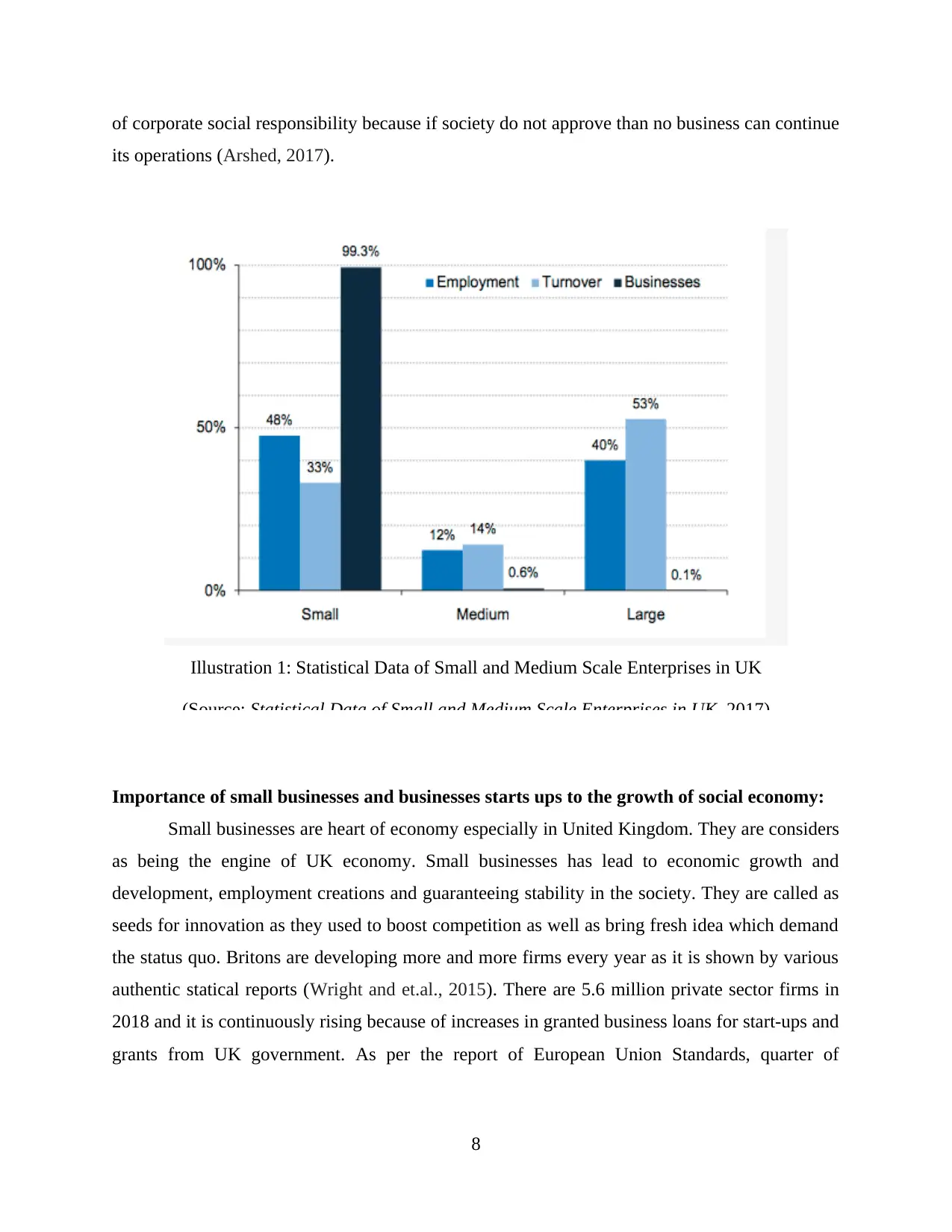
of corporate social responsibility because if society do not approve than no business can continue
its operations (Arshed, 2017).
Importance of small businesses and businesses starts ups to the growth of social economy:
Small businesses are heart of economy especially in United Kingdom. They are considers
as being the engine of UK economy. Small businesses has lead to economic growth and
development, employment creations and guaranteeing stability in the society. They are called as
seeds for innovation as they used to boost competition as well as bring fresh idea which demand
the status quo. Britons are developing more and more firms every year as it is shown by various
authentic statical reports (Wright and et.al., 2015). There are 5.6 million private sector firms in
2018 and it is continuously rising because of increases in granted business loans for start-ups and
grants from UK government. As per the report of European Union Standards, quarter of
8
Illustration 1: Statistical Data of Small and Medium Scale Enterprises in UK
(Source: Statistical Data of Small and Medium Scale Enterprises in UK, 2017)
its operations (Arshed, 2017).
Importance of small businesses and businesses starts ups to the growth of social economy:
Small businesses are heart of economy especially in United Kingdom. They are considers
as being the engine of UK economy. Small businesses has lead to economic growth and
development, employment creations and guaranteeing stability in the society. They are called as
seeds for innovation as they used to boost competition as well as bring fresh idea which demand
the status quo. Britons are developing more and more firms every year as it is shown by various
authentic statical reports (Wright and et.al., 2015). There are 5.6 million private sector firms in
2018 and it is continuously rising because of increases in granted business loans for start-ups and
grants from UK government. As per the report of European Union Standards, quarter of
8
Illustration 1: Statistical Data of Small and Medium Scale Enterprises in UK
(Source: Statistical Data of Small and Medium Scale Enterprises in UK, 2017)
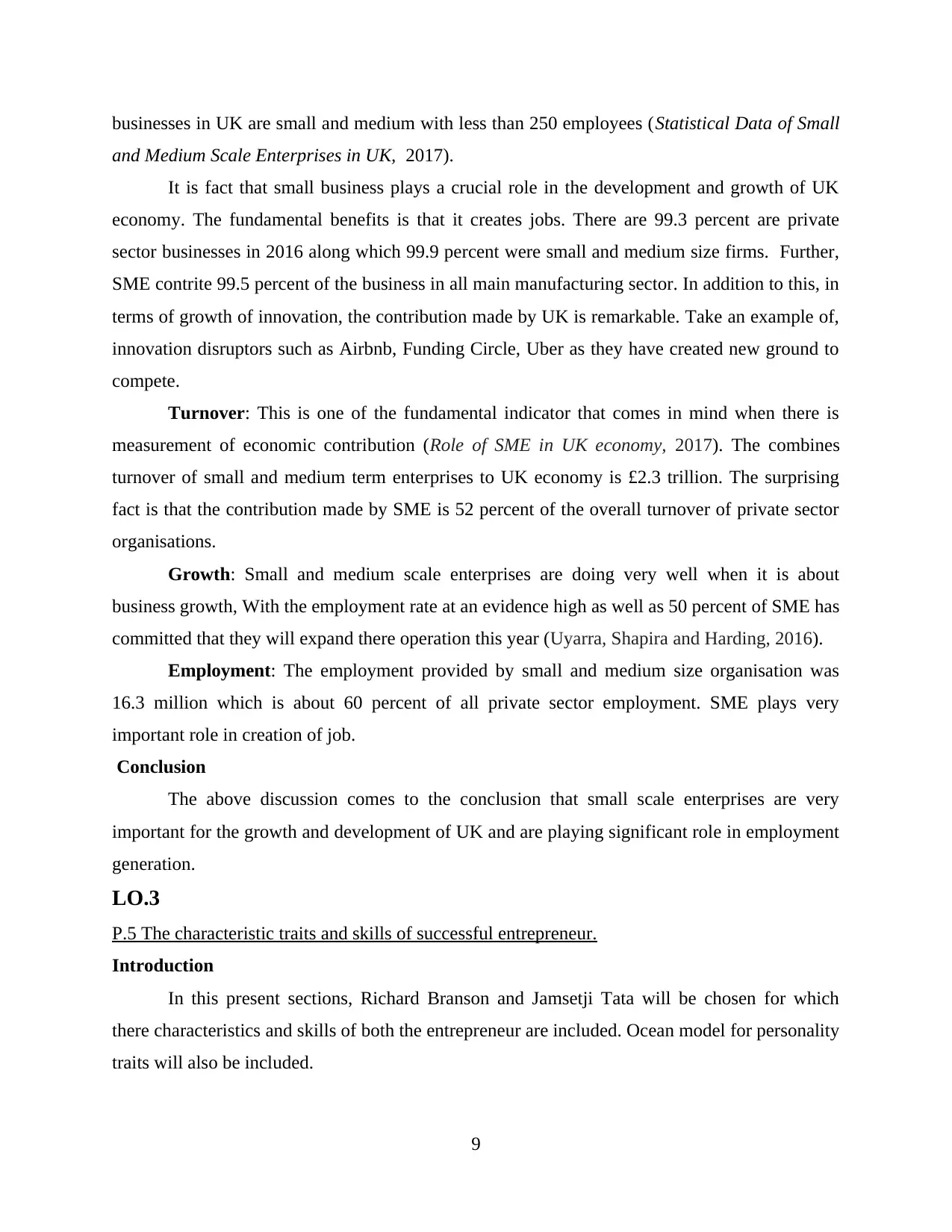
businesses in UK are small and medium with less than 250 employees (Statistical Data of Small
and Medium Scale Enterprises in UK, 2017).
It is fact that small business plays a crucial role in the development and growth of UK
economy. The fundamental benefits is that it creates jobs. There are 99.3 percent are private
sector businesses in 2016 along which 99.9 percent were small and medium size firms. Further,
SME contrite 99.5 percent of the business in all main manufacturing sector. In addition to this, in
terms of growth of innovation, the contribution made by UK is remarkable. Take an example of,
innovation disruptors such as Airbnb, Funding Circle, Uber as they have created new ground to
compete.
Turnover: This is one of the fundamental indicator that comes in mind when there is
measurement of economic contribution (Role of SME in UK economy, 2017). The combines
turnover of small and medium term enterprises to UK economy is £2.3 trillion. The surprising
fact is that the contribution made by SME is 52 percent of the overall turnover of private sector
organisations.
Growth: Small and medium scale enterprises are doing very well when it is about
business growth, With the employment rate at an evidence high as well as 50 percent of SME has
committed that they will expand there operation this year (Uyarra, Shapira and Harding, 2016).
Employment: The employment provided by small and medium size organisation was
16.3 million which is about 60 percent of all private sector employment. SME plays very
important role in creation of job.
Conclusion
The above discussion comes to the conclusion that small scale enterprises are very
important for the growth and development of UK and are playing significant role in employment
generation.
LO.3
P.5 The characteristic traits and skills of successful entrepreneur.
Introduction
In this present sections, Richard Branson and Jamsetji Tata will be chosen for which
there characteristics and skills of both the entrepreneur are included. Ocean model for personality
traits will also be included.
9
and Medium Scale Enterprises in UK, 2017).
It is fact that small business plays a crucial role in the development and growth of UK
economy. The fundamental benefits is that it creates jobs. There are 99.3 percent are private
sector businesses in 2016 along which 99.9 percent were small and medium size firms. Further,
SME contrite 99.5 percent of the business in all main manufacturing sector. In addition to this, in
terms of growth of innovation, the contribution made by UK is remarkable. Take an example of,
innovation disruptors such as Airbnb, Funding Circle, Uber as they have created new ground to
compete.
Turnover: This is one of the fundamental indicator that comes in mind when there is
measurement of economic contribution (Role of SME in UK economy, 2017). The combines
turnover of small and medium term enterprises to UK economy is £2.3 trillion. The surprising
fact is that the contribution made by SME is 52 percent of the overall turnover of private sector
organisations.
Growth: Small and medium scale enterprises are doing very well when it is about
business growth, With the employment rate at an evidence high as well as 50 percent of SME has
committed that they will expand there operation this year (Uyarra, Shapira and Harding, 2016).
Employment: The employment provided by small and medium size organisation was
16.3 million which is about 60 percent of all private sector employment. SME plays very
important role in creation of job.
Conclusion
The above discussion comes to the conclusion that small scale enterprises are very
important for the growth and development of UK and are playing significant role in employment
generation.
LO.3
P.5 The characteristic traits and skills of successful entrepreneur.
Introduction
In this present sections, Richard Branson and Jamsetji Tata will be chosen for which
there characteristics and skills of both the entrepreneur are included. Ocean model for personality
traits will also be included.
9
⊘ This is a preview!⊘
Do you want full access?
Subscribe today to unlock all pages.

Trusted by 1+ million students worldwide
1 out of 20
Related Documents
Your All-in-One AI-Powered Toolkit for Academic Success.
+13062052269
info@desklib.com
Available 24*7 on WhatsApp / Email
![[object Object]](/_next/static/media/star-bottom.7253800d.svg)
Unlock your academic potential
Copyright © 2020–2025 A2Z Services. All Rights Reserved. Developed and managed by ZUCOL.





